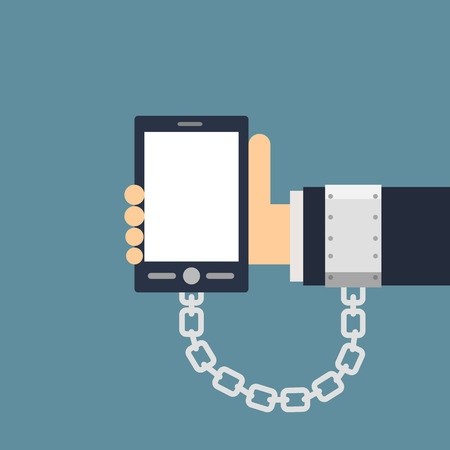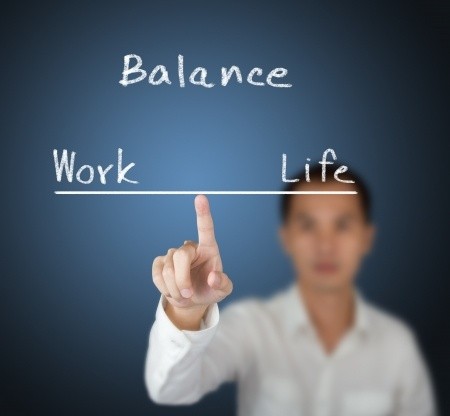
(This is a feature I did for Entrepreneur Magazine and for people everywhere, struggling to balance work and life.)
As a college buddy was recounting a great trip to Europe, something snapped inside Jeff Platt. "It was like all of a sudden I woke up," recalls the CEO of Sky Zone Indoor Trampoline Park.
Though only 24 at the time, Platt was exhausted. He'd been working 16-hour days, seven days a week, for two years since launching the Los Angeles-based company's second trampoline park, this one in St. Louis. He had taken no vacations, had no social life whatsoever. In the bootstrap tradition, he was doing it all in the early days of the venture started by his father, Rick. But that habit is sustainable only until the reality of mental and physical limits strikes.
"I felt like I was missing out," he says. "All I was doing was busting my butt. I was tired. I had to slow down. I stepped back and said, it's time to hire some people."
Entrepreneurs are often celebrated for wearing multiple hats and logging numerous hours. But working without letup is a bad habit that can jeopardize business, health and the life you're supposedly working toward.
It's easy to fall into the trap of overdoing it, since capital in the early days is tight, but also because few ambitious achievers understand one of the biggest secrets of productivity--the refueling principle. It comes down to this: You get more done quicker when you step back and recharge the brain and body. Studies show that performance increases after breaks of all durations: from extended vacations down to microbreaks of 30 seconds. .
RUNNING OUT OF JUICE
Continuous time on-task sets off strain reactions, such as stress, fatigue and negative mood, which drain focus and physical and emotional resources. The brain's ability to self-regulate--to stay disciplined--wanes with each exercise of self-control during the day. It's a loss of resources that must be replenished, or it becomes harder to stay on-task, be attentive and solve problems.
"There is a lot of research that says we have a limited pool of cognitive resources," says Allison Gabriel, an assistant professor of management at Virginia Commonwealth University who studies job demands and employee motivation. "When you are constantly draining your resources, you are not being as productive as you can be. If you get depleted, we see performance decline. You're able to persist less and have trouble solving tasks."

That's counterintuitive in a culture programmed to believe that it takes near-nonstop work to get the sale, beat the competitor or do whatever is needed to succeed. For most entrepreneurs, rest is considered the province of lesser mortals, put off for a future that never arrives. It's as if each day is an Ironman triathlon that requires one to crawl across the finish line on all fours.
Dan Sullivan, co-founder of Toronto-based Strategic Coach and co-author of The Laws of Lifetime Growth, says it's this mentality that keeps entrepreneurs exhausted, stuck and reaping a fraction of potential profits. He has built a multimillion-dollar coaching business in part by advising entrepreneurs to do the last thing in the world they would ever think to do: take time off. His anthem is that productivity and performance start with free time, which he argues is the fuel for the energy, creativity and focus that lead to success.
"It's not the amount of time you spend working each day," Sullivan says. "Entrepreneurs get paid through problem-solving and creativity. You can create a solution in a shorter period of time if you are rested and rejuvenated."
One of his clients, Jonathan Gassman of the Gassman Financial Group in New York, is a believer. Before Sullivan's program, he was a self-admitted workaholic who each year took maybe a week's "vacation" that wasn't one, since he spent much of it checking in electronically with the office. Since allowing himself free time under Sullivan's guidance, "my personal and company income are up dramatically, and I've started two businesses I wouldn't have otherwise," he says. "More quality time off is what really catapulted things." He now takes off six weeks per year, unattached to the office.
Work-life balance isn't a theoretical frill. It's a necessity for performance. After years on the burnout track, racking up long hours and heavy business travel, Saurabh Bhatia found his normally high energy reservoir tapped out. "I wasn't getting the energy I was used to, and the sense of joy was missing," says Bhatia, co-founder and CEO of mobile video ad company Vdopia in Fremont, Calif. Then he heard a TV commentator talking about how basketball star LeBron James had taken a break to recharge. That, Bhatia figured, was what he needed, too.
Bhatia put together his own program of "boosts," which include daily breaks (walking meetings, lunch with a friend, a swim); unplugged weekend activities such as hiking or driving with family and friends; and home activities, such as cooking, that relieve stress.
"You shouldn't have to slog through every day," Bhatia says. "I'm working smarter now, and finding that doing less is more impactful. My brain is getting more nutrition. On the life side, I'm able to pay more attention to my health and spend more time with my daughter."
As Bhatia has discovered, productivity doesn't come from being glued to the helm every waking moment but from how energized and, as a result, focused and organized your brain is. Humans are just like smartphones or iPods: We have to be recharged, or we run out of juice.
MANAGING MENTAL RESOURCES
Most of us wouldn't think twice about taking a breather after an hour of basketball or Zumba, but mental fatigue is another story. The brain is usually seen as an ethereal realm that exists apart from the body and the laws of physiology. Yet gray matter tires well before the body does. Since almost all of us are doing mental work these days, managing cognitive resources is not a nice thing to be able to do; it's essential.
The brain is "like a muscle. You can strengthen it or deplete it," Gabriel says. "If you let this muscle recharge and replenish, you'll feel better mentally and see improvements in your performance."
Regular refueling--input--is a prerequisite for quality output, because the brain is an energy machine, consuming 20 percent of the body's calories, even though it's only 2 percent of total body mass. Energy that gets expended must be resupplied.
Just like the heart, the brain gets fatigued from too much time on-task. "If you overtax your heart, the next thing you need to do is relax, or you'll die," says Jeff Stibel, CEO of Dun & Bradstreet Credibility Corp. and author of Wired for Thought, among other books. "The same thing is true of the brain. Do too much, and you'll burn it out. You'll make bad choices."
One study found that mental fatigue takes hold after three hours of continuous time on-task; other scientists say brains need a break after 90 minutes, the length of the "basic rest-activity cycle."
Burning up mental resources without replacing them leads to stress, burnout and poor performance. Stress constricts the brain to a narrow focus--a perceived threat--making it hard to concentrate on anything else, plan or make good decisions.
In the course of staying focused on a task, we use up a key cognitive resource: self-control. Studies show that regulating our emotions is taxing. Known in research circles as ego depletion, this holds that every time we exercise self-regulation--paying attention, suppressing emotions, managing how we act to conform to a cultural norm--we use limited regulatory resources and reduce the ability for further self-control, depleting energy and causing fatigue.
"Engaging in effortful choice and decision-making has been shown to lead to impairments in subsequent self-control," report the authors of a study from Florida State University and Texas A&M University that proved that self-regulation creates a fuel shortage for brain activities. (That fuel is blood glucose.)
From your calf muscles to your brain neurons, the pattern is the same: Activation of energetic resources requires a period of recovery. How? You shut off the flow of demands by stopping or resting, or by building up new resources, such as energy and control, to replace those that have been lost. The goal is psychological detachment from the stress and strain that cause negative activation--feelings of tension, distress, anger, dissatisfaction and fatigue--and engagement in positive activation that drives attention and vigor: fun, pleasure, learning and mastery.
BREAK TIME
Recovery opportunities might range from breaks during the workday to diversions that shut off the work mind when you get home at night, to weekend activities, vacations and sleep.
People who engage in respite activities during workday recovery breaks have higher levels of positive affect (observable expression of emotion) after the breaks, a study led by John Trougakos at the University of Toronto found. That restores regulatory resources that increase focus and resilience. Subjects who used the time for restorative activities--relaxing, social activities, napping--got the benefit, while those who used the time for chores--other tasks and errands--didn't.
As the longest separation from work stressors during the workday, lunch is a big opportunity for restoring energy. Working while eating lunch doesn't aid recovery, one study by Trougakos reports, while autonomy during the break "can offset the negative effects of work" and result in less end-of-workday exhaustion. Exercising during lunch is also effective. Swedish researchers found that taking two and a half hours per week for exercise during work hours increased productivity, even though workers were logging 6.25 percent fewer hours.
Vacations have been shown to lead to significantly higher performance upon return to the job. The energizing ingredients are time away from stressors (you need two weeks to get the recuperative benefits from burnout) and mastery and social experiences while on vacation that build competence and social connection.
Leaving the work at work is one of the most important recovery strategies--and the hardest. If you're still obsessing about work when you're off the job, no recovery can take place. Detaching from work with diversions at night reduces fatigue and promotes positive effects the next morning at work.
What is not an effective diversion? Watching TV. The average state of a TV viewer is a mild depression, according to Mihaly Csikszentmihalyi, author of Flow. Instead, you should try new hobbies and mastery experiences that satisfy core psychological needs such as autonomy and competence, which energize, empower and buffer job stress.
When you make time off as important as time on and have a plan to use it effectively, it can lead to the kinds of performance gains seen by Sullivan's clients. "We've quadrupled the size of the company," says Noah Katz, co-president of Foodtown/Freshtown markets, a New York firm with 850 employees. Katz has been in the Strategic Coach program for 12 years. "You need to recharge the batteries. You come back like a tiger and get more done."
DEFEATING DIY DISORDER
Even after trampoline impresario Platt had his epiphany that he needed help, actually hiring people was another story. After all the sweat equity he'd put into Sky Zone, it was hard to trust others with his baby. He started to give managers decision-making power, but then would overrule them.
Platt had a classic case of do-it-yourself disorder, an entrepreneurial affliction that burns up precious time and mental space on nonessential, grunt or out-of-skill-set tasks that take you away from the important jobs of innovating and building profitability.
"That's not being entrepreneurial at all," says Waterbury, Conn.-based Don Mroz, president of Post University and founding dean of the Malcolm Baldrige School of Business. "It's what's going to move the organization ahead, what's new and innovative that I can be working on, instead of ticking off the to-do list."
It took three years, the advice of a mentor and the realization that he was getting in the way of his company's forward progress for Platt to relinquish some of the reins. "Work started to pile up. I couldn't respond to people fast enough and lost some work," recalls Platt, whose company now has 71 trampoline parks around the world. "I had to get to the point of the business running itself."
It can take a serious pounding for entrepreneurs to admit they can't do it all, shouldn't do it all and, indeed, are going to flame out if they keep trying to do it all. Sullivan's clients often turn to him after a crisis--a marriage falls apart, they're drained by burnout. Sullivan teaches them that the very activity they thought was necessary for success--putting in extremely long hours--was likely the obstacle to it.
In his program, entrepreneurs create a new calendar in which their weeks are broken down into "free days," when no work or checking in to e-mail or the office is allowed; "buffer days," for planning and preparation; and "focus days," for high-value, goal-oriented practices. It can be shock treatment for folks who haven't had a day off in months or a vacation in years.
But after learning how to delegate, focus on what they do best and use free time to sharpen energy and clarity, Sullivan's clients may wind up taking a month or more off a year.
"By getting away from work and letting the mind get involved in thinking, hobbies and rejuvenation, you come back to the job and produce results faster," Sullivan explains.
Thinking is one of the crucial benefits of stepping back. Just as quality time off fuels energetic resources on the job, reflective time is critical to producing solutions and creative breakthroughs.
"If you don't give your employees time to think and play, you're not going to have the creativity you need to succeed," says Vincent Berk, CEO of FlowTraq, a software company in New Hampshire that solves tough cyber-security issues.
There's a good reason for that. "When you're thinking about a problem, it's confined to one or two regions in the brain," Dun & Bradstreet Credibility's Stibel says, "but the solution may not be in those areas. By resting, the information sits in your brain and then percolates across other sections of the brain."
Stibel practices what he preaches. His approximately 700 employees can choose from amenities and recovery options such as yoga classes, spinning, surfing lessons, massages and significant flextime. His top two refueling tips: get more sleep (seven to nine uninterrupted hours) and take a break every 45 to 90 minutes.
Now that he has made his staff accountable for decisions and learned to take breathers, Platt is feeling better. "Now I can leave for two weeks, and it wouldn't hurt the business," he says. "I can go to the gym every day, eat healthy food. I'm happier and have more energy at the end of the day."
If you'd like information on how to build the refueling principle into your company operations, click the button below for details on our work-life balance and sustainable performance trainings.






















